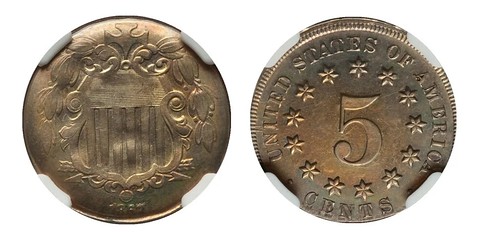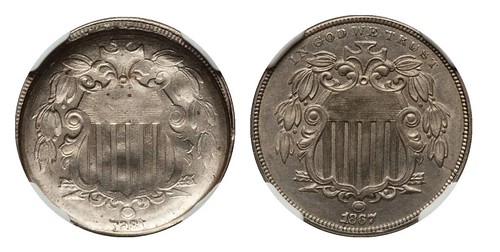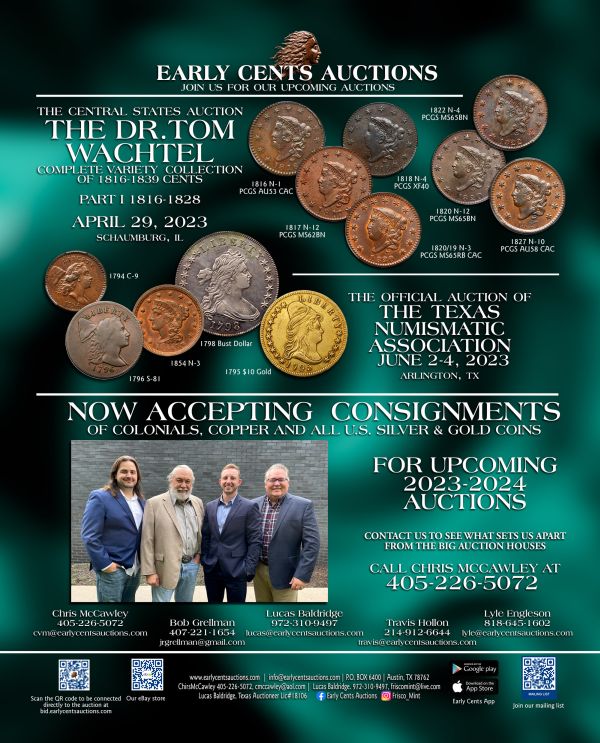
PREV ARTICLE
NEXT ARTICLE
FULL ISSUE
PREV FULL ISSUE
ERROR SHIELD NICKEL MATED PAIR DISCOVEREDLen Augsburger passed along Ken Potter's Numismatic News article about Greg Bennick's discovery of a rare mated pair of error Shield Nickels. Congratulations! Here's an excerpt - see the complete article online. -Editor Numismatic News reader Greg Bennick has discovered a mated pair of uncirculated 1867 Shield nickels under-described in auction as a lesser error type. The error pair includes planchets intended for both a copper-nickel alloy 3-cent and a Shield nickel 5-cent piece, but neither the original grading service nor auction house mentioned that a 3-cent planchet was involved. This error combination involving the planchets of two different denominations elevated the coin to a far rarer error type than if it was a mated pair of like planchets. Mated pairs are rare on United States coinage but nowhere near that of this multi-denominational mated pair. Even more unusual – not only were the two pieces struck together, but the 3-cent piece had been struck previously by Shield nickel dies rather than 3-cent dies! Upon entering the press a second time, it landed on top of a Shield nickel planchet and was struck again, imparting a Full Mirror Brockage into the Shield nickel from the first strike. The coin virtually covered the 5-cent planchet on the second strike. The difference was so slight that it was virtually undetectable, but it was enough that it almost completely hid the fact that a smaller planchet was involved. Bennick purchased the set in Heritage Auctions' Misfits Collection of U.S. Error Coinage, Part 2 as lot #93096 for $10,800 (including buyers' premium) on Dec. 21, 2022. He said, I saw the coins were described too simply by Heritage and were in third-party grading holders with labels that didn't accurately match the coins... The first coin was clearly double struck as it had left a perfect Brockage impression within the Shield nickel planchet when they were mated them together. A Brockage is the result of a planchet and a struck coin being in the coining chamber at the same time. The two items may overlap each other, rest on top of each other or be of different sizes when struck. Because this brockage represents a first impression of the coin into a planchet with no distortion, it is referred to as a Mirror Brockage or because it covers the entire design it could be called a Full Mirror Brockage. Bennick said, I thought it odd that everyone had missed describing the upper coin as double struck, which it had to have been to create a brockage on the lower coin. I also noticed that the two coins seemed to fit into one another more easily than they would if the planchets were the same denomination. The second coin had a bit of peripheral design remaining even though the first coin had been fully indented into it. I own and have studied many mated pairs, though nothing of this magnitude, and I thought if the third-party grading service had missed the double strike, that possibly they might have missed more about the pair as well. Bennick speculates that the 3-cent planchet was likely a leftover in a bin that was used previously to transport 3-cent planchets to a press for striking 3-cent pieces. For some reason, this planchet got stuck in the tote bin which was later filled with 5-cent planchets and delivered to a press striking 5-cent coins. The coin was then delivered to a press striking Shield nickels, struck and kicked back into the press and struck again while laying on top of another 5-cent planchet. This transport method is in fact the most common way for Off Metal and Wrong Planchet errors to occur. Based on the irregularities Bennick saw in the description and on the pair, he hoped there was more to the coins than was inscribed on the original holders and took a chance, winning the pair with a bid of $10,800 (including the buyer's premium). Upon closer inspection of the coins, he determined that the upper coin that appeared to be struck on a smaller planchet was in fact the weight of a 3-cent copper-nickel piece. This was later confirmed by Numismatic Guarantee Company (NGC) of Sarasota, Fla., who slabbed the coins in new holders, with one coin having been struck on a 3-cent nickel planchet and the second struck on a Shield 5-cent planchet. NGC graded each coin MS-64 and made note that a 3CN, for three-cent nickel, planchet was involved. Mark Lighterman, vice president of Combined Organizations of Numismatic Errors Collectors of America (CONECA), who has been collecting errors since the 1970s and owns the largest collection of United States Off Metal and Wrong Planchet errors, said that, while he owns three examples of Shield nickels struck on 3-cent planchets, he has never heard of one involving a mated pair, suggesting that the set is unique. Recently retired error coin dealer and former Professional Coin Grading Service attributer for error coins, Fred Weinberg of Encino, Calif., indicated to Bennick that he had never heard of any such set, not even in the legendary Conway Bolt collection that Weinberg himself had sold in the early 1970s. Bennick has been a collector of major mint errors for over 40 years since the age of 10. He said he is thrilled with the discovery, calling the set impossibly rare and hopes news of the find will draw more new error collectors into the hobby. There are still treasures to be found, he said, and it all starts with excitement and education about errors, and then close and careful study of as many coins as possible.
To read the complete article, see:
Wayne Homren, Editor The Numismatic Bibliomania Society is a non-profit organization promoting numismatic literature. See our web site at coinbooks.org. To submit items for publication in The E-Sylum, write to the Editor at this address: whomren@gmail.com To subscribe go to: https://my.binhost.com/lists/listinfo/esylum All Rights Reserved. NBS Home Page Contact the NBS webmaster 
|


